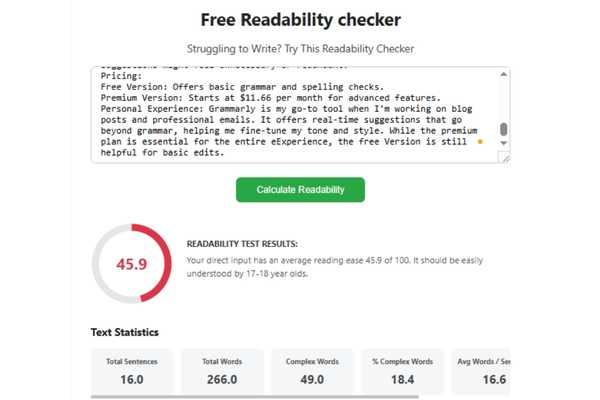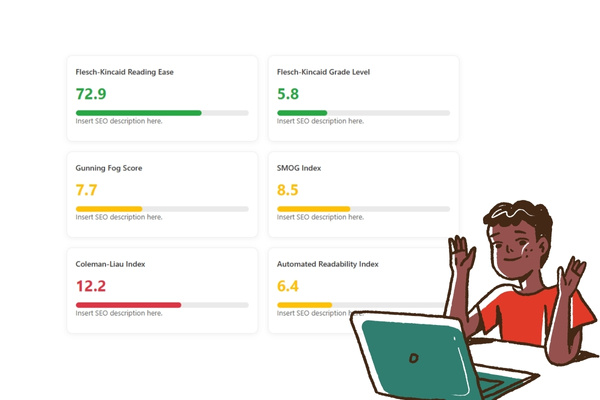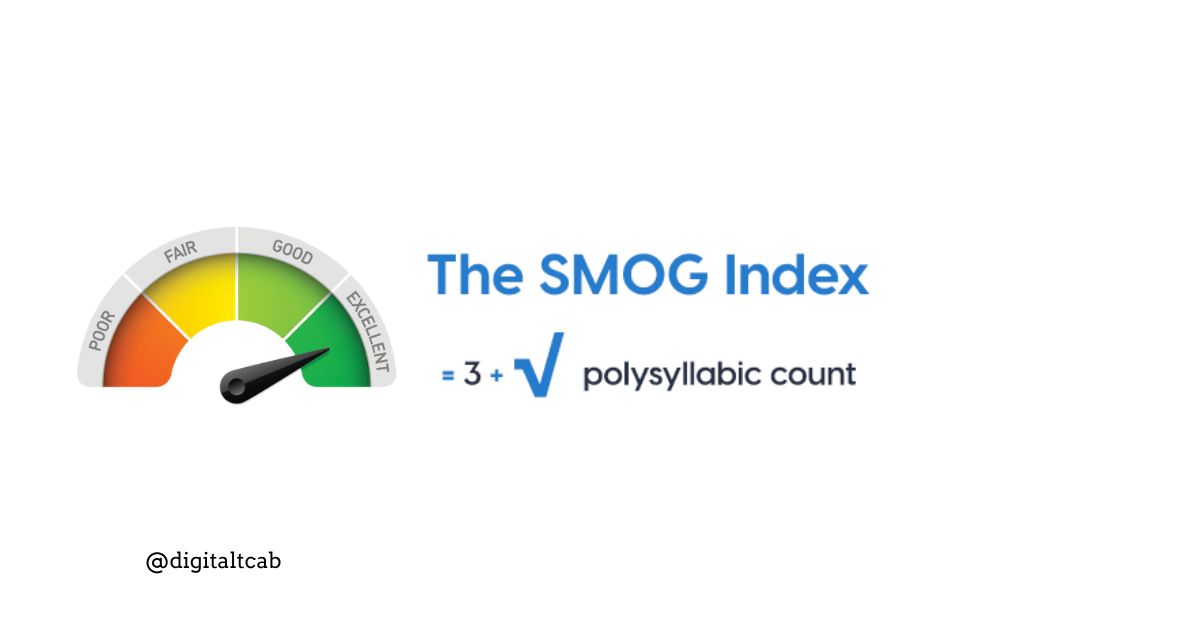Have you ever found yourself struggling to read a blog post or webpage? This is where the power of readability testing comes in. It’s a tool that empowers you to measure how easily your content can be understood by its readers. As someone who has worked with a variety of content, you know that Ease of Reading is crucial for keeping your audience engaged. In this article, I’ll explain why readability testing matters, how you can use it, and how it can empower you to make your website shine.
Table of Contents
Table of Content
Here’s what you’ll know:
- The primary Content Fluency tests, like the Flesch-Kincaid Reading Ease and Gunning Fog Score
- How to adjust your content to suit different audiences
- Mistakes to avoid when testing Text Clarity
- Tools to check how easy your content is to read.
Let’s dive in and start making your content easier to read. The process is straightforward, and with the knowledge you’ll gain from this article, you’ll be able to apply Writing Clarity testing to your content confidently.
What Is Readability Testing?
Have you ever read a blog post and found it hard to understand? That’s where Text Difficulty Level testing comes in. It’s a way to scan if your content is easy to read and comprehend.
In simple terms, readability testing helps you assess the clarity of your message. Whether you’re writing a blog, a product description, or website content, you want your words to be easy for your audience to grasp. That’s where a Ease of Reading score test is valid. It suggests that your writing matches the reading level of your audience.
I’ve used Ease of Reading tests in my work. Once, I had a technical article that was too hard to follow. After using a readability test, I simplified it. The result? Higher engagement. Small changes can make a big difference.
Check Your Content Score Instantly
Why Readability Matters
The goal of Text Quality testing is to ensure your content fits your readers’ needs. Tools like the Flesch-Kincaid calculator guide you to the grade level of your writing. If you’re writing for specialists, your content can be more problematic. But if you’re writing for a general audience, keep it simple.

As a marketer, I’ve learned that explicit content can lead to increased traffic. When readers don’t struggle with your words, they stay on the page longer. And that’s what you want.
Legibility testing helps you improve your writing and connect better with your audience. In this article, you’ll learn the best readability tests, how to use them, and how to avoid common errors.
Key Readability Tests and Scores
Legibility testing can be a game-changer when it comes to ensuring your content is easily understood by your audience. These tests help you measure the complexity or simplicity of your writing, which can make a significant difference in keeping readers engaged. Let’s take a look at some of the key readability tests that can help you fine-tune your content.
1.Flesch-Kincaid Reading Ease
First up, we have the Flesch-Kincaid Reading Ease. This test measures the Text Clarity of your content. The formula yields a score ranging from 0 to 100. The higher the score, the more manageable the text is to read. For most content, aim for a score between 60 and 80. This range is ideal for most readers, ensuring your writing is accessible.
For example, if you’re writing for the general public, save your score within this scope. If you’re writing for a specialized audience, such as engineers or medical professionals, you may need to aim for a lower score to match their advanced level of knowledge.
2.Flesch-Kincaid Grade Level
Next is the Flesch-Kincaid Grade Level, which indicates the grade level at which your content is written. For example, a score of 7 means your content is at a 7th-grade reading level. Most blog posts should aim for a grade level between 6th and 8th grade. This makes your content accessible to a broad audience. However, if you’re writing for professionals or an academic audience, a higher grade level may be more suitable.
3.Gunning Fog Score
The Gunning Fog Score is a Reading Level test that measures how complex your writing is. The higher the score, the more difficult it is to read your text. This score takes into account sentence length and the percentage of complex words (those with three or more syllables). For general content, aim for a score of 12 or below. Anything above 12 is too difficult for the average reader, suggesting that you need to simplify your writing.
4.SMOG Index
The SMOG Index (Simple Measure of Gobbledygook) is beneficial for medical, technical, or academic writing. It calculates the number of polysyllabic words (three or more syllables) in your content and estimates the years of education required to understand the text. For example, an SMOG score of 8 means the content is suitable for an eighth-grade reader. If you’re writing for a specialized audience, like doctors or lawyers, a higher SMOG score might be acceptable.
5.Coleman-Liau Index
The Coleman-Liau Index is another Comprehension Score test, but instead of syllables, it uses characters per word. This method can be remarkably accurate for online content where the length of words plays a significant role. It’s also simpler to calculate. Generally, for blog or website content, a Coleman-Liau Index between a 6th and 8th-grade level is ideal.
6.Automated Readability Index (ARI)
The ARI is a test that calculates Writing Clarity based on the average number of characters per word and the average sentence length. It then provides a grade-level score. The ARI is an excellent tool for quick checks of digital content because it’s based on simple elements, such as word length and sentence structure.

How to Use Readability Scores in Practice
When it comes to Ease of Reading, one size doesn’t fit all. The way you tailor your content depends on who you’re writing for. Let’s break down how to optimize your content for different audiences and ensure you hit the proper readability levels.
Optimizing Content for Different Audiences
First things first, consider who you’re writing for. When creating content for kids, you’ll want a more straightforward writing style compared to content for a B2B audience. For example, writing for children means using simpler words, shorter sentences, and avoiding complex concepts. On the other hand, for a B2B audience, you can use more industry-specific terminology but still aim to make the content easy to read.
For general web content, a great rule of thumb is to aim for a Flesch-Kincaid grade level of around 6 to 8. This ensures most readers can understand it without having to work too hard. If you’re writing something more technical or professional, you might aim for a higher grade level—make sure you’re matching your content to your audience’s expectations.
Practical Tips for Better Readability
Now, let’s get to the good stuff: how to make your writing more transparent and easier to understand.
- Use Simple Sentence Structures: Try to keep your sentences short and to the point. This makes it easier for readers to process your content and helps improve your Flesch-Kincaid score. The simpler, the better!
- Avoid Jargon (Unless Necessary): Jargon is fine for niche audiences who understand it, but for the general public, it can be a barrier. If you must use technical terms, ensure that you define them clearly and concisely.
- Use Short Paragraphs and Bullets: Big blocks of text can be overwhelming. Break up your content into small paragraphs and use bullet points to highlight key information. This makes your content more scannable and less intimidating to readers.
Common Mistakes to Avoid When Testing Readability
Ease of Reading tests are valuable tools, but they can lead to errors if not used with care. Here are a few things to avoid to ensure your content remains effective and engaging.
Over-Simplifying Content
It’s easy to think the simpler, the better. However, if you aim for too low a grade level, you might lose important details. If you’re writing for experts, like doctors or engineers, you can’t simplify everything too much. The goal is to strike a balance. Your content should be explicit, but it must also convey the proper depth for your audience.
Neglecting Context
Understanding Index scores help, but they don’t tell the whole story. Sometimes, a higher readability score is needed for more technical writing. If you’re writing for a professional audience or tackling a complex topic, it’s okay to have a higher score. The context of your content is crucial. Don’t let scores dictate everything.
Focusing Too Much on One Metric
I’ve made this mistake myself. It’s tempting to rely solely on one Understanding Index score, such as the Flesch-Kincaid Grade Level. But this only tells part of the story. If you focus exclusively on that, you might overlook other key factors. Consider a mix of readability tests to gain a comprehensive understanding of how your content is performing.
Why Readability Testing Matters for SEO
Impact on User Experience
Have you ever visited a website and left it immediately because the content was too difficult to read? That’s the power of Content Clarity, and it directly affects user experience. When your content is easy to read, people tend to stay longer, explore more pages, and are less likely to bounce. On the other hand, if your content is difficult to understand, users will leave quickly, resulting in a higher bounce rate. By keeping your content engaging and straightforward, you help keep users on your site longer, which is precisely what you want for a better user experience.
SEO Benefits
However, here’s the kicker: Text Simplicity not only improves the user experience; it also enhances it. It also plays a significant role in your SEO. Google and other search engines prioritize user engagement when ranking websites and web pages. If visitors are bouncing quickly because they can’t understand what you’re saying, search engines take note. A higher bounce rate can signal to Google that your content isn’t valuable, which could hurt your rankings.
On the other hand, if your content is easy to digest, visitors will stay on your page longer, which signals to Google that your content is engaging and valuable. This improves your time on the page and ultimately boosts your SEO. In short, readability is a hidden gem for SEO!
Conclusion
So, why does readability testing matter?
Because your message doesn’t mean much if no one gets it; that’s the heart of it. Whether you’re writing a blog post, a landing page, or even a how-to guide, if your words are too hard to follow, your readers will bounce faster than a cat off a wet floor.
Here’s a quick recap:
- Readability tests, such as Flesch-Kincaid and Gunning Fog, help you assess how easy your content is to read.
- Different tests are more effective for various types of content; what works for a product page may not work for a medical white paper.
- Adjusting for your audience is key. Write like you’re talking to them, not lecturing.
- Simple tips work wonders: use shorter sentences, fewer syllables, and avoid jargon (unless your reader is already familiar with it).
- Don’t stress over one score. Use them as guides, not strict rules.
Quick takeaway: Reading Level testing helps you create content that connects more effectively, performs better, and resonates with your audience for a more extended period.
Try It Yourself (Seriously!)
Before you hit publish on your next blog or web page, run it through a Reading Level checker. You’ll be surprised at what you catch. And how easily it can be fixed.
Here’s one I use and recommend: Readability Test (free, fast, and super simple).
You can also try the built-in readability stats in Microsoft Word or browser tools like Grammarly or Yoast SEO if you’re using WordPress.
Quick answer: Use free Text Difficulty Level tools like Digitaltcab Readability Test or Grammarly to test the clarity of your content instantly.
My Final Word? Don’t Write to Impress. Write to Connect.
I used to write “smart.” Long sentences. Fancy words. And guess what? No one read it. Once I started writing as if I were talking to a friend, with shorter thoughts and real stories without fluff, things began to change. Engagement went up. SEO improved. People responded.
Readability isn’t just a metric; it’s a mindset.
Snippet-friendly tip: Clear writing builds trust, keeps readers on your page, and boosts your content’s performance across the board.
So go ahead. Check your next piece. Simplify. Clarify. Make it something your audience enjoys, not just something they read.
For more readability tips
- How can I test my resume for ATS readability
- how can i test the readability of my translated text
- how can i improve the readability of my test cases
- Fry Readability Graph
Frequently Asked Questions (FAQ)
What is a good Flesch-Kincaid reading ease score?
A score between 60 and 80 is solid for most web content. However, if you’re writing for a general audience, I recommend aiming for 70+ words or more to maintain smooth and clear communication.
I aim for 75–85 words per blog post and landing page. That’s the sweet spot where people stop scrolling and start reading. Think of it like writing the way you speak, naturally and humanly.
Quick Answer: A good Flesch-Kincaid score is 70–85 for general content. Higher is better for clarity.
How do I improve my readability score?
Oh, this one’s fun. Start by trimming the fat. Shorten your sentences. Cut out complex words (unless they need to be there). Break things up, use bullets, headings, and whitespace like seasoning on a great dish.
Here’s a trick I use: read your content out loud. If you trip over a sentence, so will your reader.
Quick Answer: Use short sentences, simple words, and clean formatting to boost your readability fast.
What is the best readability score for SEO?
There’s no magic number, but Google loves user-friendly content. If your page reads like a chat with a wise friend, you’re on the right track.
I’ve seen posts rise in search rankings simply by being easier to read. Why? People stay longer, bounce less, and enjoy the content.
Quick Answer: Aim for a readability score above 70. It helps users stay longer, which is excellent for SEO.
What readability level should my website content be at?
Think 7th or 8th grade. That’s not dumbing it down. It’s brilliant writing. You want to be clear, not clever. Even if your audience is full of PhDs, they’re still reading on phones while multitasking or late at night. Make it easy for them.
I usually write at a 6th to 8th-grade level, even for technical topics. If it’s easier to read, it’s easier to trust.
Quick Answer: Shoot for a 6th to 8th-grade level for most online content.
How accurate are readability tools?
They’re helpful but not perfect. Readability tools like the Flesch-Kincaid calculator or Gunning Fog checker give you a quick pulse, not a diagnosis. I use them like a GPS; they show where I might need to adjust, but I still drive the car.
The key is to balance the numbers with common sense and real-world testing. Does the content feel easy to read? Do readers stay longer? That matters more than any score.
Quick Answer: Readability tools are a guide. It’s not a gospel. Use them to check your writing, but always trust your reader’s experience.





Leave a Reply